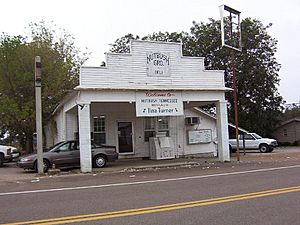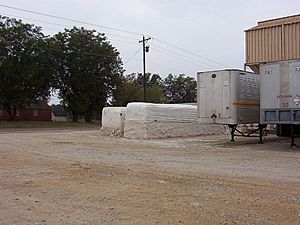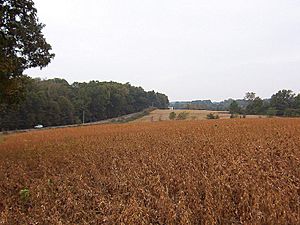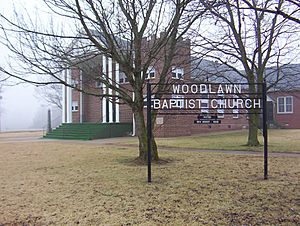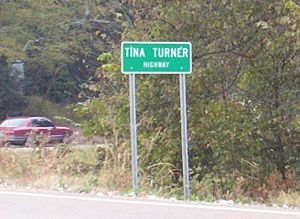Nutbush, Tennessee facts for kids
Quick facts for kids
Nutbush, Tennessee
|
|
|---|---|
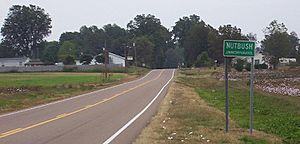 |
|

Location in the state of Tennessee
|
|
| Country | United States |
| State | Tennessee |
| Counties | Haywood |
| Elevation | 358 ft (109 m) |
| Population
(2000) of the Nutbush voting precinct
|
|
| • Total | 259 |
| Time zone | UTC-6 (CST) |
| • Summer (DST) | UTC-5 (CDT) |
| ZIP code |
38063 (Ripley)
|
| Area code | 731 |
Nutbush is a small, rural community in Haywood County, Tennessee, in the western part of the state. It's about 50 miles northeast of Memphis.
This community was started in the early 1800s by settlers from Europe. They brought African Americans who were forced to work on cotton farms. Many old houses and churches from that time are still standing today.
Farming is still very important to Nutbush's economy, especially growing and processing cotton. Cotton has been the main crop since the early days when it was grown using forced labor. As of 2006, there was one cotton processing plant in the community.
Nutbush is famous as the childhood home of the singer Tina Turner. She even sang about the "town" in her 1973 song "Nutbush City Limits". In 2002, a part of Tennessee State Route 19 near Nutbush was named "Tina Turner Highway" to honor her. It's also the hometown of blues musicians Hambone Willie Newbern and Sleepy John Estes.
Contents
Life and Work in Nutbush
The main way people in Nutbush make money is through agriculture, especially growing cotton.
After slavery ended, many freed people worked as sharecroppers. This meant they farmed small pieces of land, mostly for cotton. In return, they gave a part of their crops to the landowner.
Today, modern machines like the cotton picker do most of the work. Because of this, many farm workers moved to cities during the Great Migration in the early 1900s. As of 2006, the only farming industry left in Nutbush was one cotton processing plant.
The Tennessee Valley Authority (TVA) also runs a power plant called Lagoon Creek Peaking Facility in Nutbush. This plant uses eight gas turbines to create electricity for the area when a lot of power is needed.
A Look at Nutbush's Past
The Nutbush community began in the early 1800s. Settlers from Virginia and North Carolina moved west to the Mississippi River delta in western Tennessee. They developed this area for growing cotton, and they relied on forced labor.
These settlers started Trinity United Methodist Church in 1822. During the time of slavery, enslaved Black people were made to attend this church under the watch of white people.
More than 50 soldiers from the American Civil War, both Confederate and Union, are buried in the Trinity Cemetery. This cemetery is connected to the church. The Trinity Cemetery is known as one of the best-kept cemeteries in the county.
The community also had Woodlawn Church, which was only for white people and is still active. Before the Civil War, most Black church groups had to have white pastors. In 1846, a man named Hardin Smith, who was enslaved, was allowed to preach to a Black group at an evening service at the white Woodlawn Church. This was the first time an enslaved person led a church service in the area.
After the American Civil War, the Woodlawn Missionary Baptist Church was started in 1866. Hardin Smith and other freedmen (freed enslaved people) from the community, with help from some white members of Woodlawn Baptist Church, founded it. The freed people soon created their own church groups, separate from white supervision. Most Black Baptists in the South did the same by the end of the century.
Woodlawn Baptist Church was added to the National Register of Historic Places in 1996 because of its important history.
A U.S. Post office opened in Nutbush in 1881 but closed in 1905.
Where is Nutbush?
Nutbush is located at 35°41′53″N 89°24′29″W / 35.69806°N 89.40806°W. It sits at an elevation of 358 feet (109 meters) above sea level.
The area around Nutbush is mostly made up of cotton fields and rolling hills. Nutbush is also on the southeastern edge of the New Madrid Seismic Zone. This is an area where there is a higher risk of earthquakes.
Postal and Telephone Information
The U.S. ZIP Code for Nutbush is 38063, which is shared with Ripley. The telephone area code for the area is 731.
Famous People from Nutbush
Early Black musicians and singers from Nutbush churches recorded music that became known around the world. Famous recording artists include Hambone Willie Newbern and Sleepy John Estes. The Harmonica player Noah Lewis, from nearby Henning, Tennessee, is buried in a cemetery close to Nutbush.
Nutbush is best known as the childhood home of singer Tina Turner. Her birth name was Anna Mae Bullock, and she was born in nearby Brownsville on November 26, 1939. She grew up in Nutbush, Knoxville, and Ripley, raised by her grandmother and other family members. The houses she lived in as a child are no longer there. Wood from her Nutbush home was even used to build a barn. When she was 16, she moved to St. Louis, Missouri.
Both Woodlawn Missionary Baptist Church and Spring Hill Baptist Church in Nutbush were churches her family attended. Tina Turner sang in both choirs when she was growing up. Her family members were church leaders, musicians, and singers. Many of her family members are buried in these two cemeteries.
In 2002, Tennessee State Route 19 between Brownsville and Nutbush was officially named "Tina Turner Highway" in her honor.
Nutbush in Pop Culture
- Tina Turner's song "Nutbush City Limits" (released in 1973 and produced by Ike Turner) is all about her hometown.
- The line dance called "The Nutbush" is performed to this song.
- The song was also featured in "Diva", an episode in the fourth season of the TV show Glee.
Images for kids


